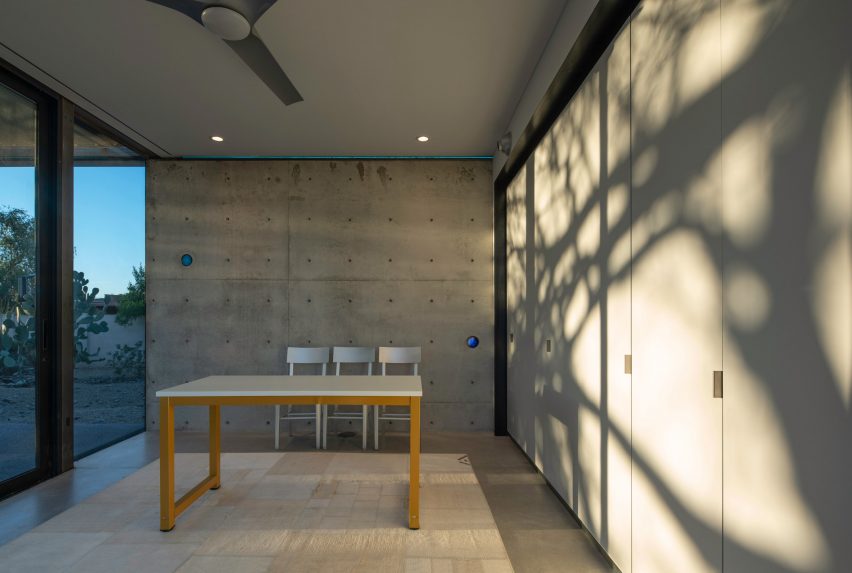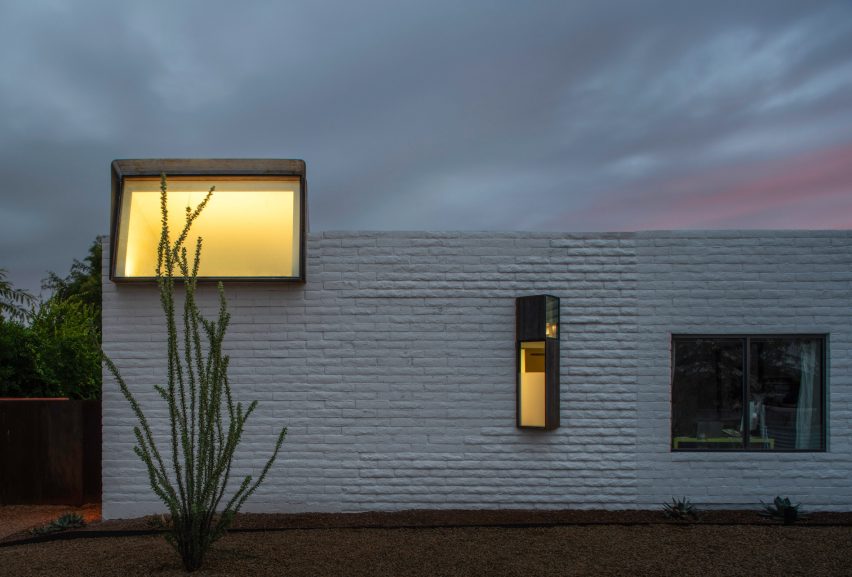
Amit Upadhye Architects orients Arizona home to the stars
Local studio Amit Upadhye Architects added a guest house and updated Polaris House in Arizona to capture the "diurnal journey of the sun".
Located on a one-acre desert property in Paradise Valley, Polaris House is named after and directed toward the North Star.

In 2023, Amit Upadhye Architects, which is based in nearby Scottsdale, updated and extended the Arizona School house – designed by architect Eddie Jones – for an Arizona State University professor and scientist and a mathematician to connect with the geometry of the sky.
The existing house was constructed with locally sourced slump block that is inexpensive, low-maintenance and durable in the harsh Arizona climate.

The team chose to continue sourcing materials for the addition with the same priorities to reduce the environmental impact and cost.
In the main house, the team renovated the primary bathroom and closet – a small space measuring 273 square feet (25 square metres) – to serve as a "sanctuary and observatory" by adding three distinct apertures.

A metal hood rises out of the white brick house facing Polaris. It draws soft northern light through a clerestory opening, along the sloped ceiling and down into the shower, and shields the space from the summer sun with a perforated brise soleil.
Meanwhile, a low rectangular window with a translucent tangerine-coloured film illuminates the shower bench from the east. A triangular protrusion in the form of an oriel window brings both morning eastern and evening western light across the vanity.

"This way the entire diurnal journey of the sun across the sky is captured and rendering the space differently at different times of the day," the team said.
The guest house – a nearly symmetrical 550-square foot (51 square metre) pavilion – works in dialogue with the existing home, weighing the main home's rough masonry with the guest house's steel-framed roof and three-sided glazing.

Outdoor patios hold the east and west ends, leading through floor-to-ceiling glass doors to parallel bedrooms that could be either bedrooms or offices. Closets and a bathroom form a core in the centre of the space.
The southern wall of the guest house is exposed concrete perforated with seven small holes. These were arranged to form the Big Dipper constellation with coloured lenses that represent abstracted desert flowers and serve as a place for small desert animals and birds to hide.

"The clients are nature lovers and love watching the local flora and fauna in their backyard," Amit Upadhye Architects said.
"We have deployed synanthropic strategies on other parts of the house where the synanthropes such as birds and bees are encouraged to roost in the thick concrete walls making the exterior wall a living membrane," the studio added.
"Their love for urban farming is an added bonus contributing to the ecosystem."
The residence includes a self-reliant system with solar panels and a client-installed, battery-powered Tesla Ecosystem that partially powers the main house and supplies energy that can be returned to the electrical grid to support other households.
Additionally, the project is fitted with water-conserving plumbing fixtures and onsite rainwater retention strategies to preserve the vital resource in Arizona's Sonoran Desert.

Other recently completed homes in Arizona include a weathering steel Flagstaff home outfit with a lookout tower by The Ranch Mine and a Corten steel-clad cabin that disappears like a "dark shadow" into the red rocks of Sedona by Wendell Burnette Architects.
The photography is by Matthew Winquist.
Project credits:
Architect: Amit Upadhye AIA of AU Design Studio
Design team: Rigo Berber, Yuanyu Liu, Amadeus Cruz
General Contractor: SmithBuilt Design Build
Structural Engineer: Augsperger Komm Engineering
Civil Engineering: Land Development Group
Electrical Engineering: Tuley Engineering Professionals
Mechanical Engineering: NP Mechanical
Concrete: Lavek Concrete
Glass: Mountain View Glass and Mirrors
Masonry: GV Masonry
Structural Steel: Kachina Steel
Plumber: Fair Plumbing
Electrician: DE Electricians
Architectural Metals: Weld Works
Painting: Supernova Painting
Roofing: Ultra Foam Roofing